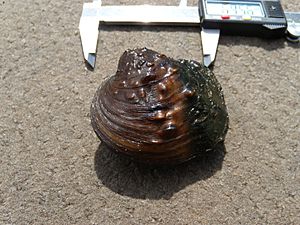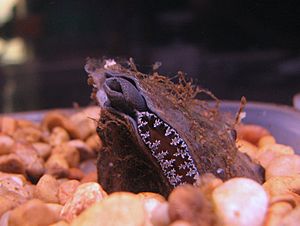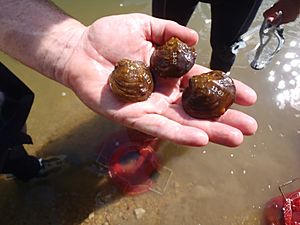Winged mapleleaf facts for kids
Quick facts for kids Winged mapleleaf |
|
|---|---|
 |
|
| Conservation status | |
| Scientific classification | |
| Genus: |
Quadrula
|
| Species: |
fragosa
|
The winged mapleleaf is a special type of freshwater mussel. It's also called the false mapleleaf or hickory nut shell. Its scientific name is Quadrula fragosa. This amazing aquatic creature is a bivalve mollusk, which means it has two shells that hinge together. It belongs to the family Unionidae, known as river mussels. The winged mapleleaf is only found in the United States.
This mussel lives in just a few areas of Wisconsin, Minnesota, Arkansas, and Missouri. These states are in the Midwestern United States. The winged mapleleaf is a critically endangered species. This means it is at a very high risk of disappearing forever.
Contents
What Does It Look Like?
The shell of the winged mapleleaf mussel has a unique shape. One end, called the anterior end, is slightly round. The other end, the posterior end, looks more like a square.
The shell can be different colors. It might be yellowish-green, light brown, or even dark brown. Inside, the shell is usually white. Sometimes, it has shiny, rainbow-like colors at one end. A grown-up winged mapleleaf mussel is usually about 4 inches (10.2 cm) across.
These mussels have very thick shells. Unlike many other mussels, their shells have bumps. These bumps run from the hinge down to the edges of the shell. The special patterns of these bumps help scientists tell the winged mapleleaf apart from other mussels that look similar.
Where Does It Live?
The winged mapleleaf mussel lives in medium to large streams and rivers. You might find it in mud, but it prefers gravel or sandy river bottoms. This mussel needs to live in moving water to survive. The water depth must be between 0.4 and 2.0 meters (about 1.3 to 6.5 feet). Most importantly, the water must be clean and free of pollution.
Where Can You Find It?
A long time ago, the winged mapleleaf mussel lived in thirteen different states. It was found in almost all the rivers and streams that flow into the Mississippi River. It also lived in some rivers that flow into the Missouri River.
Today, things are very different. The mussel can only be found in four rivers in the Midwestern United States. Even in these rivers, it lives in only small areas.
- A five-mile stretch of the St. Croix River between Minnesota and Wisconsin.
- The Ouachita River in Arkansas.
- The Saline River in Arkansas.
- The Bourbeuse River in Missouri.
The population in the St. Croix River is the only one that is growing and having babies. In the other three rivers, there's no proof that the mussels are reproducing. Scientists believe there are only about 50 to 1000 winged mapleleaf mussels left alive today.
What Does It Eat?
The winged mapleleaf mussel is a filter feeder. This means it siphons water and filters out tiny food particles. It eats very small organisms like phytoplankton (tiny plants) and zooplankton (tiny animals).
When they are very young, winged mapleleaf mussels attach themselves to the gills of a host fish. They feed and grow there. Once they are big enough, they leave the fish. Then, they can filter water from the river on their own to get food.
Reproduction and Life Cycle
The winged mapleleaf reproduces in a way similar to many other freshwater mussels. Male mussels release their sperm into the water. Female mussels then siphon in the water, and the sperm fertilizes the eggs inside them. The eggs are kept on the female's gills.
After fertilization, the eggs grow into tiny larvae. Once the larvae are ready, the mother mussel releases them into the river current. These tiny larvae must then find a host fish and attach to its gills to continue growing. The only known host fish for the winged mapleleaf are the Channel catfish and the Blue catfish.
The larvae stay on the host fish until they reach their next stage of life. Then, they drop off the fish and settle onto the river or stream bottom. There, they grow into adult mussels. Scientists are still trying to understand why only Channel catfish and Blue catfish can successfully host the mussel larvae.
Researchers have even tried to place the larvae onto other types of fish. However, their studies were limited. They found very few eggs to use, and many of the captive fish died. The limited results still showed that only Channel and Blue catfish were successful hosts. The oldest known winged mapleleaf mussel was found in the St. Croix River. It was estimated to be 22 years old, but their full lifespan is still unknown.
What Are the Threats?
The winged mapleleaf mussel faces many dangers that threaten its survival.
- Zebra mussels: An invasive species called the Zebra mussel (Dreissena polymorpha) is a huge problem. These mussels take over habitats and food sources. Zebra mussels started causing problems in the St. Croix River in 2000. The U.S. Fish and Wildlife Service is working to control them.
- Pollution: Dirt and pollution in the water are also major threats. The reproducing population in the St. Croix River is close to the city of St. Paul. As cities grow, more dirt and pollution can get into the river. This also changes how the river flows, causing erosion and different water levels. The winged mapleleaf needs a clean environment and specific water levels to live.
- Dams: Dams upstream can also change water levels. The U.S. Fish and Wildlife Service is trying to manage this issue.
The biggest problem is that there is only one known population that is reproducing. This means a big flood, a pollution spill, or a dam breaking could easily wipe out the entire species. This would cause the winged mapleleaf mussel to become extinct.
How Are People Helping?
The winged mapleleaf mussel was added to the list of endangered and threatened animals on July 22, 1991. This means it is now against the law to collect, harm, or kill these mussels. Special permits can be given by the U.S. Fish and Wildlife Service for research projects. However, these permits are very hard to get. The states of Wisconsin and Minnesota are working with the U.S. Fish and Wildlife Service to control the zebra mussel invasion.
Scientists have also released an experimental group of winged mapleleaf mussels into the wild. These mussels were released in parts of the Tennessee River in Colbert and Lauderdale counties. It is not yet known if these released mussels are reproducing.
Many dam operations upstream are now watched more closely. This helps make sure there is enough water flow in the St. Croix River for the mussels to survive and reproduce. The river levels are kept between 0.4 and 2.0 meters, which is what the mussel needs.
Images for kids
See also
 In Spanish: Quadrula fragosa para niños
In Spanish: Quadrula fragosa para niños







